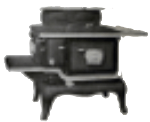Reflections
As the last project of my undergraduate degree, I tried to put as much as I could into this project. I had completed an Omeka exhibit for a previous class but I wanted to retry this approach and build upon what I had learned previously and try to include new things. I think I felt overall better about my experience in working through this idea, even with the challenges I faced and the things that I wish I had either done differently or sooner.
In setting up this project, I had spent a fair amount of time reworking early on the idea of how to approach looking at stoves, gender, and advertising without focusing too much on the foundation of work that had already been done. In shifting more towards the technology itself, rather than just the advertisements, I needed to get familiar with how to work with such documents since I had never done this sort of project before. I think it would have been best to have spent a shorter, more concentrated amount of time thinking about it so that I would have been able to focus more quickly on my primary and secondary sources.
Through the course readings and the professor’s suggestions, I had a fairly good understanding of how to go about my project, but I did try and read as much as I could which took some time due to my slow reading speed when I need to fully comprehend the subject matter. I was able to quickly get together a quantifiable source base early on with the mail-order catalogues available from Library and Archives Canada, which was helpful in setting the groundwork for understanding what kind of stoves I would be working with. I was also able to expand on these sources by looking at the trade literature collection at the Ingenium library. I wish I had the foresight to have looked at this collection earlier as I was rather delayed in looking at the materials and probably would have better represented them in this project if I had taken more time with them.
Having experienced working with the Omeka platform I felt comfortable diving into it without needing to spend as much time understanding how it works. I did find that the organization process for an Omeka exhibit takes the most time to figure out the best way to display the information without overwhelming the reader with a massive block of text and too many unincorporated visuals. This was also combined with my desire to build on my coding skills while creating this exhibit. I did learn about things like inserting styles, CSS measurements, and animating properties, but I had taken the time learning them without reaching the successful point of inputting them how I was looking to. As I move onto graduate studies in the Master of Infromation program at Dalhousie University, I am looking to take a class that focuses on learning programs like CSS and I will hopefully be able to use what I have learned in this project development and take it into that course.
As one final note, I have included excerpts from this McClary’s Household Manual from 1923 that I was not able to fully integrate into my project, but greatly enjoyed looking through as a source of the stove’s place in a home.
Flipbook made of McClary's Household Manual book excerpts made by the McClary Manufacturing Company in 1923. (Omeka entry in the Collection Gallery)
